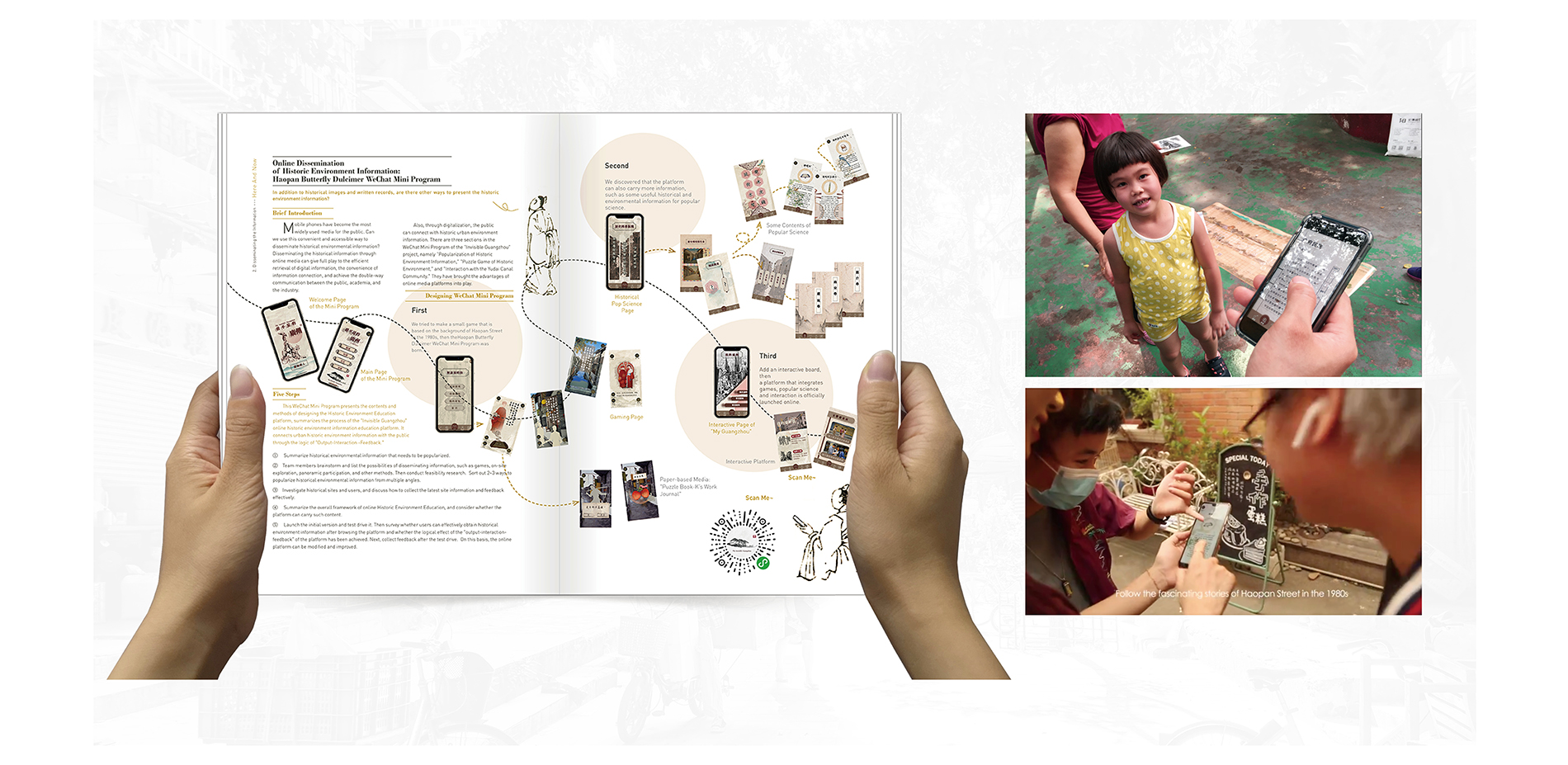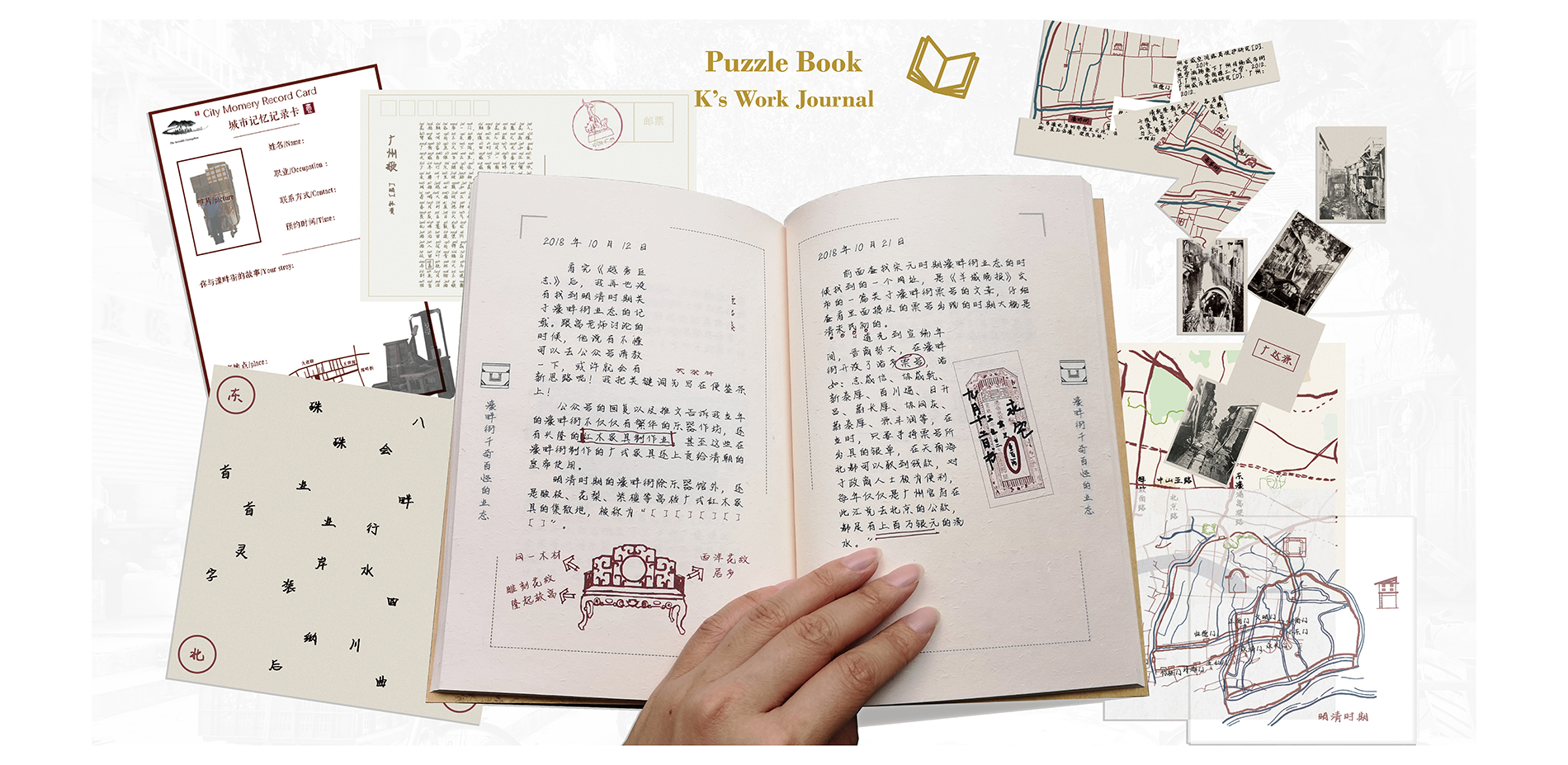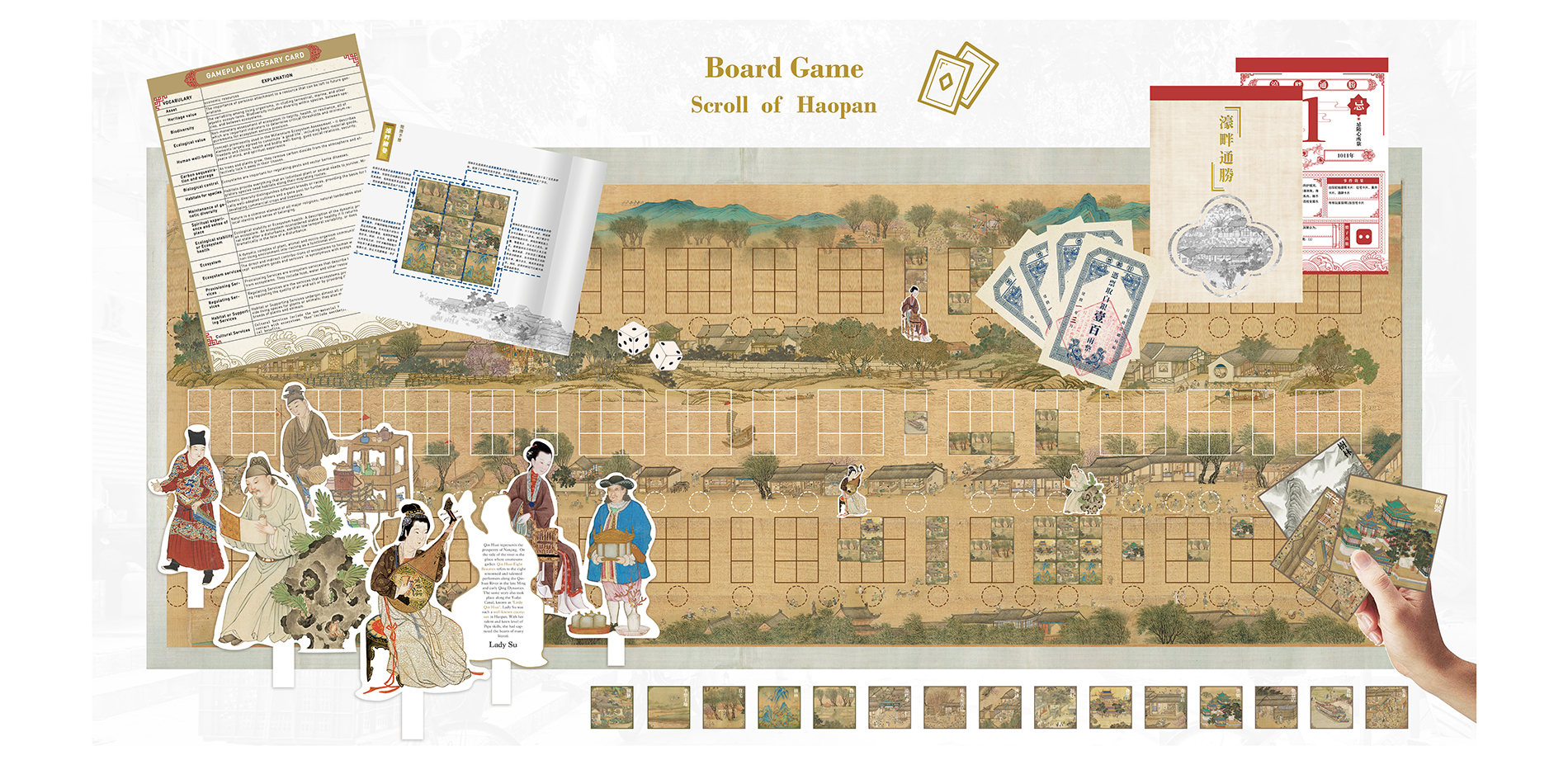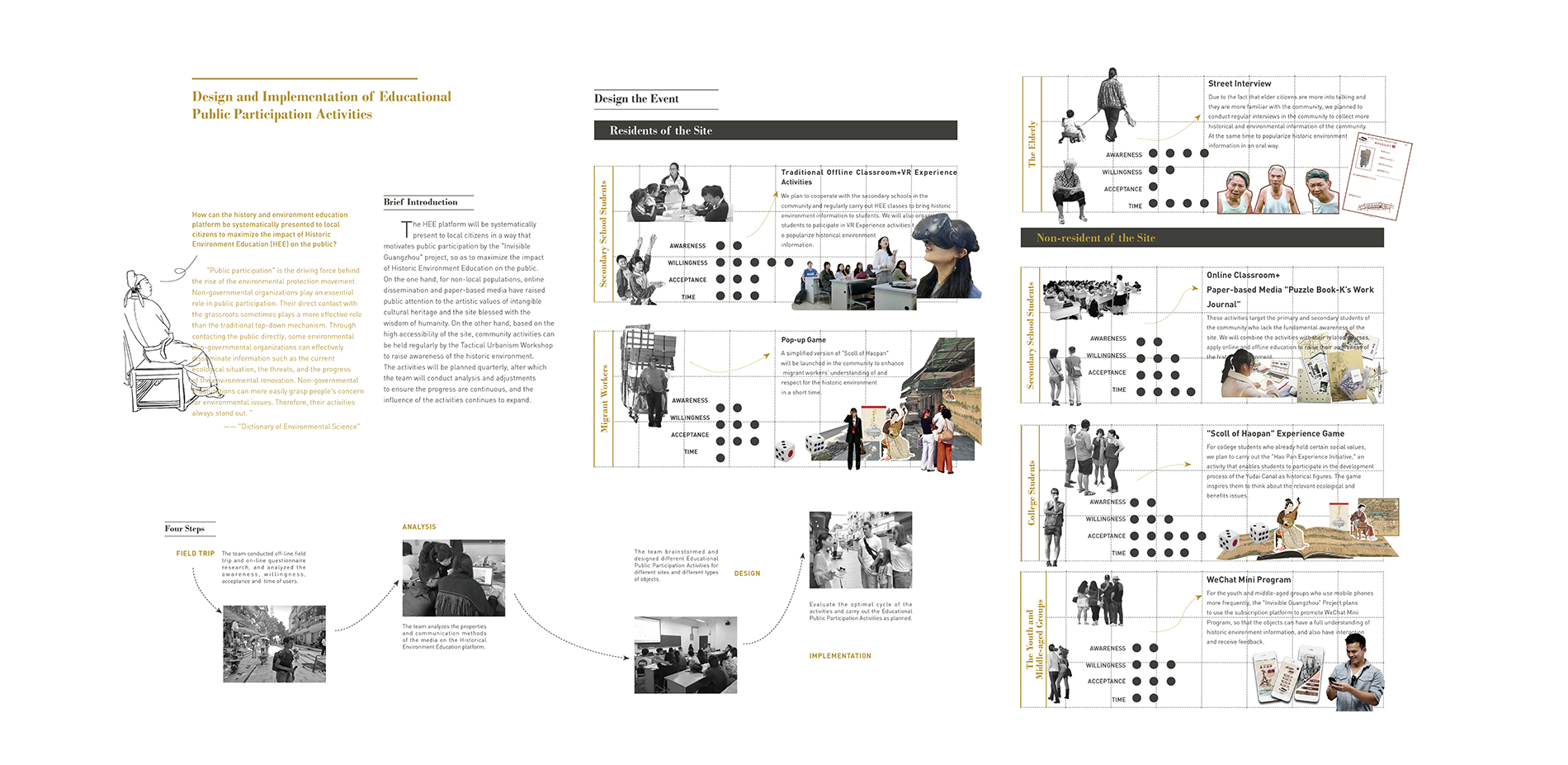Invisible Guangzhou—A Historic Environment Education Project
Honor Award
Communications
Yuwei Guo, Student ASLA; Chuxin Feng; Jielin Chen; Xuening Wang
Faculty Advisors: Wei Gao; Fanying Jiang
South China Agricultural University
Using a broad, inclusive spectrum of engagement methods—from in-person interviews to a WeChat app to a board game—students were able to connect with community members to convey the historic importance of the Yudai Canal, which was once the moat around Guangzhou, China. Using questionnaires that gauged participants’ familiarity before and after these interactions, this team demonstrated the efficacy of communication not only in raising awareness of neglected historic and ecological resources, but also in garnering support for preservation in the face of rapid urban development.
- 2020 Awards Jury
Project Statement
In responce to some high-value historical landscapes of Guangzhou city being destroyed by the rapid urbanization process, the "Invisible Guangzhou" Historic Environment Education project takes the Yudai Canal, the moat of the ancient Guangzhou city as the research object. It has built a Historic Environment Education Platform from the bottom-up perspective of public participation, and explored the methods and ideas of Historic Environment Education.
By designing public participation activities, the project helps the public to establish a correct attitude towards the historic urban environment in the process of popularizing historic environment information. The goal of this project is to enable the masses to reflect on their life, thus can better preserve historic urban landscapes of Guangzhou. After the above work is completed, we have compiled the "Invisible Guangzhou" Historic Environment Education Guidebook to record this process. We hope that this guidebook can guide more educators to build their local Historic Environment Education Platform.
Project Narrative
Objectives and Significance
Based on the historic urban landscape of Yudai Canal in Guangzhou, China, the "Invisible Guangzhou" project aims to build a Historic Environment Education platform from the standpoint of integrity and sustainability of the historic urban environment. Also, bottom-up public participation is the main focus of the activities. Through Historic Environment Education, services of introducing the historic urban environment of Guangzhou are also provided for the masses. By gathering and popularizing historic urban information, knowledge, and experience of Yudai Canal in an entertaining and intriguing way, this project attracts and maintains the public's attention to Guangzhou's historic environment and establishes a sustainable relationship between citizens and the city's historic environment.
Guangzhou has a city construction history of more than 2200 years. The legacy of traditional wisdom that was hand down by the changes in the urban environment is still of great value to the construction of urban environment and quality city life. However, with urbanization taking off, the public has lost track of the basic understanding of Guangzhou's history. Many Guangzhou's historical landscapes with regional characteristics have been forgotten by the public and are not being preserved.
Audience
The "Invisible Guangzhou" Historic Environment Education Platform project aims at younger citizens of Guangzhou.
The "Invisible Guangzhou" Historic Environment Education Guide Book mainly aims at community workers and workers of environmental education. They can build a customary Historic Environment Education Platform with the instruction of the manual. Historic Environment Education should be carried out from four aspects: Construction of the Historic Environment Information Database, Disseminating Information of the Historic Environment, Development of educational public participation activities, Performance evaluation of Historic Environment Education and its future development.
Specific content
1. Project Background
As a moat and typhoon shelter of the south of Guangzhou, Yudai Canal is blessed with great historic value and ecological wisdom that is crucial for dealing with urbanization of the present. Such content is the important part of what this project aims to convey to the audience. From the Song Dynasty to the Qing Dynasty (1010s-1900s) in China, the businesses along the Yudai Canal thrived and gradually, Haopan Street became the commercial and cultural center of Guangzhou. However, due to excessive development, in the 1930s, Yudai Canal had become a gutter, and was converted into a sewer in 1952.
2. Overall Design Idea
Based on the framework of KAP theory (Knowledge-Attitude-Behavior model), the Historic Environment Education platform has explored some methods and ideas of historic environment education.
By designing public participation activities, the project helps the public to establish a correct attitude towards the historic urban environment (A-attitude) in the process of popularizing historic environment information (K-knowledge), and hopes the educatee are able to reflect on their life, thus can better preserve historic urban landscapes of Guangzhou (P-practice). Meanwhile, the platform gives the science popularization education of historic environment through the historic urban environment information database, as well as online and offline information communication media. It also further summarizes the knowledge of eco-social infrastructure services (K-knowledge) provided by historic environment to the masses.
3. ( K-knowledge ) Popularization of Historic Environment Information
1) Construction of Historic Environment Information Database
The project has first collected and sorted out historic environment information and built an online information database, then has restored the 3D model of the site on the basis mentioned above.
2) Dissemination of Historic Environment Information
Aiming at online dissemination, the project has designed a WeChat Mini project( APP in WeChat), which includes "Popularization of historic environment information", "Puzzle Game of Historic Environment" and "Interaction with the Yudai Canal Community". They have brought the advantages of online media platforms into play.
For offline dissemination, the project has designed a puzzle game book which requires readers to dig up important clues of the historic landscape along the Yudai Canal by decrypting historical stories.
3) Re-understanding and Re-choosing of Changes in the Historic Environment
The project has designed a board game, in which historical events that had a significant impact on the Yudai Canal were recreated. It requires players to balance the relationship between humans and nature, rethink of the choices, and save the vanished Yudai Canal.
4) Implementation of Educational Public Participation Activities
With the help of the tools mentioned above, the project goes deep into the local community to carry out community activities through pop-up game, outdoor classes, online education, etc.
4. Establishment of Correct Values (A-attitude)
After carrying out a series of historic environment education activities, the project has conducted interviews to examine whether the expected goals were achieved. The content of the interviews is based on urban historical landscapes and ecosystem services. Based on the interview results, the project then has conducted the performance evaluation of Historic Environment Education.
5. Guidance of Follow-up Behaviors (P-practice)
After the activities, the project has paid a return visit to the public, inviting them to fill in a record card and writing down what impact these educational activities had on their life, work and study.
Project Outcome
1. "Invisible Guangzhou" Historical Environmental Education Guide Book:
https://issuu.com/xueningwang/docs/_______
The guide book has been distributed in the community. In the follow-up work, the project will actively collect suggestions from community workers and environmental educators on the guide book and apply them to the revision of the guide book.
2. WeChat Mini Program( APP in WeChat) :
https://youtu.be/1Fgto2wJ10M
Haopan Butterfly Dulcimer WeChat Mini Program has successfully logged on to WeChat platform, with more than 500 registered users so far.
3. WeChat Official Account:
The project has registered an official account on WeChat platform, which is used to record and display the results of the activity and launch the preview of the activities. Up to now, the cumulative number of readings of the article has reached 5300.
4. Puzzle Books:
https://issuu.com/xueningwang/docs/puzzle_book-k_s_work_journal_10
Game books have been successfully distributed in the community and received good feedback. This book will be officially published as part of the follow-up work.
5. Board Games:
https://issuu.com/xueningwang/docs/scroll_of_haopan_rulebook
As part of the coming-up project, the game will enter the general education classes of primary and secondary schools in Yudai Canal community as a new tool for local primary and secondary students to understand local history.
6. Community Building Activities:
https://www.youtube.com/watch?v=Zsc08l70-N4&feature=youtu.be
The activities are planned to be carried out quarterly. After the activities, the team will conduct design analyses and adjustments to ensure their viability.
7. Information Exchange Forum:
The project was presented at The 4th Digital Landscape Architecture International Conference held by Southeast University in 2019 and received many valuable suggestions from experts and scholars.
















